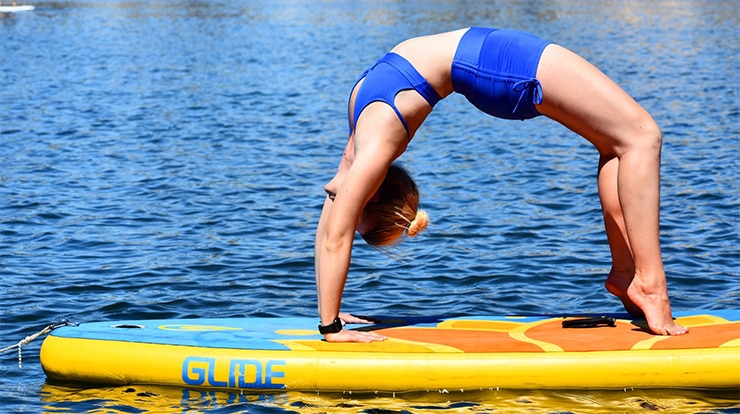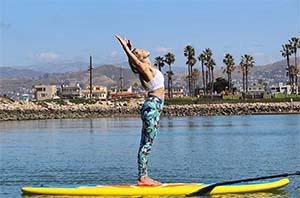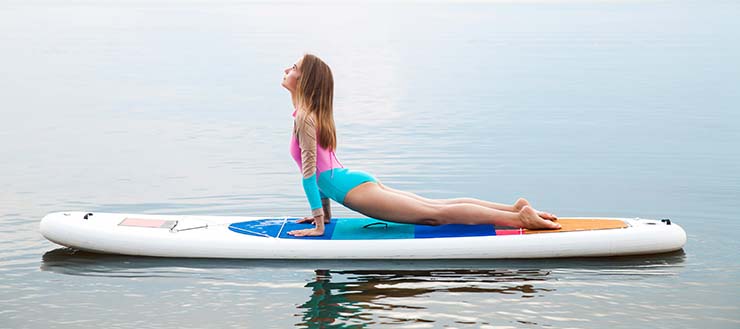If you’re interested in paddle boarding and yoga, you’ll probably be happy to know that it’s possible to combine the two. Yes – you can do yoga on a SUP board
All you need is a stable paddle board that is wide and long enough, a suitable body of water to practice on, and a desire for the added challenge that yoga on a paddle board provides!
It doesn’t really matter whether you have much yoga experience – either on the water or on solid ground – with a little focus and determination you can strike some poses and start to reap the benefits of iSUP yoga right away.
RELATED: What are the best paddle boards for yoga in 2024?
Why Do Yoga on a Stand Up Paddle Board?
Paddle board yoga is a fun activity that tests your balance and core strength. It adds an extra dimension to your regular yoga practice by introducing the challenge of balancing on a paddle board.
Taking your yoga exercises from land to the water can give you a boost in both your muscles and in your enjoyment of the sport. It’s challenging, but also super relaxing for both body and mind.
SUP yoga offers a new challenge to those who want to improve their balance, target different muscles, or simply try out a new yoga routine. It’s also a fun way to improve focus and great for practicing mindfulness and breath work.
ALSO READ: What are the health benefits of SUP yoga?

Pick the Right Board for your SUP Yoga Practice
Let’s start by picking the right board. You can find paddle boards that are specifically marketed for water yoga, but that doesn’t mean you have to opt for one of these boards over, say, an all around model.
Picking a stand up paddle board that you’re comfortable with, that suits your needs, and offers stability is key.
Do I Need a Specialized SUP for Yoga?
As previously mentioned, no, SUP Yoga doesn’t require a specialized board, although there are Yoga boards available.. However, you do want to use a board that has features that lend well to SUP yoga.
The right type of board for SUP yoga is one that is wide, long, and has a cushioned deck so that you can be comfortable while you exercise. A 10 or 11 foot board with a width of 34 to 36 inches is ideal.
Also, opt for a bord that has a deck with grab handles on the side as opposed to the middle (you don’t want a handle right in the centre where you’ll be paracticing and may want to lay down).
Stability is Key
The stability of your board is the most important feature to pay attention to as this will keep you from falling into the water. As you may have guessed, wider SUPs will offer greater stability.
You’ll also want a board that is rigid, with a grippy deck pad (as this will effectively serve as your mat). Having some traction underfoot is good for poses that require you to shift the weight to the balls of your feet – such as downward facing dog or three legged dog.

Consider a Yoga Paddle Board
Inflatables are definitely the way to go, as they have a consistent thickness across their width which will help keep you stable. This isn’t the case with many epoxy, rigid SUPs that taper off in thickness at the edges. Plus, an inflatable is easy to pack and tote along wherever you want to go.
Paddle Board Yoga Safety Tips
As with any water activity, it’s important to practice safety, even if you’re in shallow, calm waters. Here are some safety tips to keep in mind when you practice yoga on the water.
Anchor Your Paddle Board
If you’re exercising in a relatively calm body of water, then you don’t necessarily need to anchor your paddle board. However, anchoring your paddle board can help you stay in place if the wind were to pick up or if a wave were to suddenly come below you.
On a windy day or over choppy waters, it would be in your best interest to bring an anchor. An anchor can also help you pick a great spot because you can measure the depth of the water beneath by measuring when your anchor reaches the floor.
Lastly, be mindful not to do SUP yoga in shallow water. If you fall off, head first, you may hit or injure yourself or even hit your head on rocks, branches, and other debris in the water.
ALS READ: Discover the 9 best paddle board anchors in 2024
Transition Slowly Between Yoga Poses
Practicing yoga poses, even ones you’re super comfortable with will automatically be more difficult or may require some adjustment while on the water.
You might need to switch from standing on your board to kneeling on your knees instead while you learn (particularly for poses such as mountain pose, where you would normally be upright).
When you do your yoga routine on land, you don’t have to worry about the floor shifting under you. On the water, however, you will constantly need to adjust your weight in order to keep your balance.
Because of this, it’s important to take your time and transition slowly between yoga poses. As you transition, keep your arms out so that you can maintain your balance. Transitioning slowly will also minimize your risk of tipping over and falling into the water.

Keep a Wide Stance and Two Points of Contact
One of the best ways to keep your stability is by maintaining a wide stance with your legs when you transition. A wide stance will help stabilize your board and will allow you to maintain your balance.
One of the best tips to keep in mind is maintaining two points of contact on the board at all times. This is, of course, unless you’re doing a yoga stance like tree pose that requires balancing on only one leg.
ALSO READ: How hard is paddle board yoga?
Bring Along the Right Gear
Bringing along essential gear can help keep you safe during your workout in case of an emergency. Being out in the fresh air is certainly invigorating, but it does mean exposure to the elements.
This means wearing the correct clothing and taking adequate sunscreen with you.
You should also take a life jacket or PFD. You don’t have to wear your life jacket during your workout, but do wear it when you’re getting to your workout location.
If you’re doing SUP yoga in the later hours of the day, bringing a whistle and a waterproof flashlight is also important.
YOU MAY ALSO LIKE: What should you wear for sup yoga?
Conclusion
The world of paddle boarding is one that is only growing. Over the past decade, SUP yoga has been growing right alongside it. Whether you want to take SUP yoga classes, or want to work a stress management angle into your regular paddling sessions, combining stand up paddle boarding with yoga is a super activity.
If you’re looking to get started with some mindful meditation and stretching over the water’s surface, then this sport is one that you should certainly try out!

